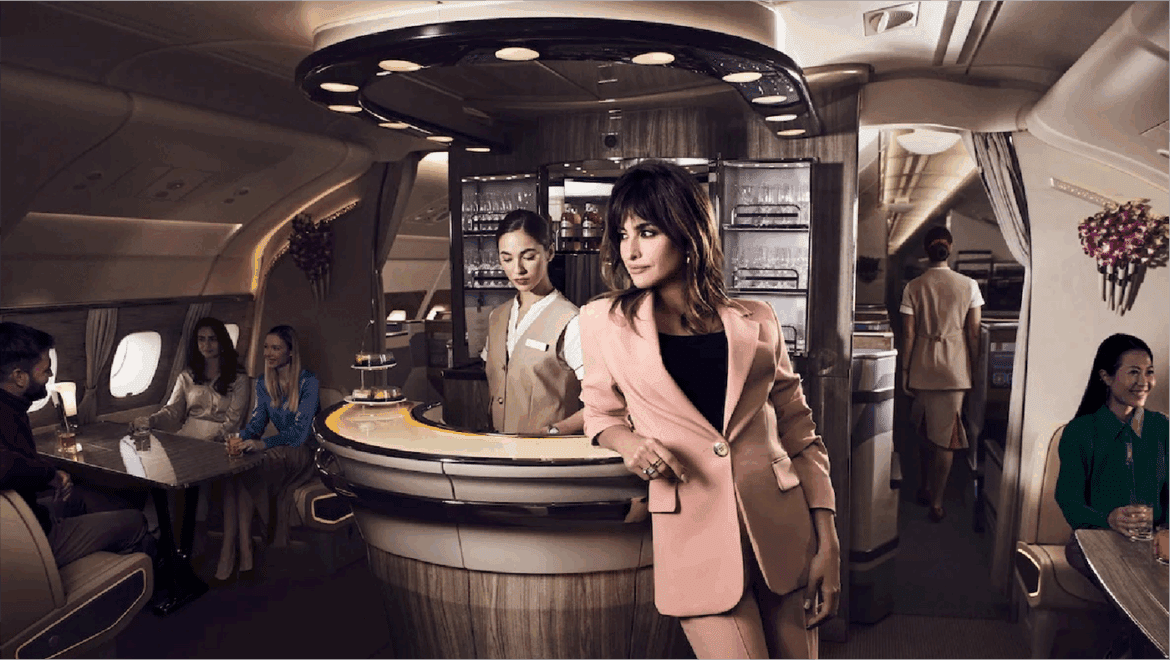In today’s marketplace, success is no longer measured solely by the quality of a product—it’s measured by how it makes a consumer feel. Emotional design has become the new frontier of business, where companies are learning to engineer emotions rather than sell products.
A recent example is Emirates’ campaign featuring Penélope Cruz, which masterfully captures this concept. Rather than showcasing destinations or aircraft, the cinematic ads invite viewers into the sensory and emotional experience of luxury travel—soft lighting, ambient music, and Cruz’s effortless grace embodying comfort, aspiration, and belonging. It’s not about flying; it’s about feeling transported, both emotionally and physically.
By integrating neuroscience, scent, and tactile experiences, brands are creating deep emotional resonance that transforms ordinary transactions into lasting connections. The goal is not just to sell an item, but to evoke a sense of belonging, aspiration, and emotional elevation that endures long after the purchase is made.
Brands have mastered the art of appealing to the brain’s emotional and reward systems, bypassing the logical decision-making centers in favor of pure feeling. Neuroscience reveals that the act of buying something desirable releases dopamine—the brain’s “feel-good” chemical—triggering sensations of pleasure and satisfaction. The purchase itself becomes the reward, transcending the object’s practical use.
This emotional response is amplified through associations with status and identity. A Chanel handbag or a Patek Philippe watch doesn’t simply signify ownership—it communicates accomplishment, sophistication, and self-worth. When consumers see luxury logos, the brain areas tied to prestige and confidence light up, producing a tangible boost in self-esteem. Mirror neurons add another fascinating layer to this phenomenon. When consumers see influencers or celebrities associated with a brand, their brains subconsciously mirror those emotions of success and desirability. Purchasing the same product feels like a pathway to embodying that lifestyle.
Even price plays a psychological role. Studies show that higher prices don’t just suggest exclusivity—they actually make products feel more pleasurable to use. The brain interprets cost as quality, heightening emotional satisfaction. Add to this the power of scarcity and exclusivity—through limited editions, waitlists, and members-only releases—and brands turn fear of missing out into one of their most effective tools for emotional persuasion.
To build lasting emotional bonds, leading companies don’t rely on visuals alone—they orchestrate experiences that engage all five senses, creating a world their customers want to inhabit. Scent, for instance, is the sense most deeply linked to memory and emotion. That’s why brands like Chanel, Dior, and the Ritz Paris employ signature fragrances throughout their boutiques and hotels. The moment a client walks in, they are enveloped in a sensory identity unique to that brand. Scented candles, diffusers, and personal fragrances extend that experience into customers’ homes, turning brand loyalty into something lived and breathed.
Touch, too, plays a vital emotional role. Stores invite guests to feel the supple leather of a handbag or the smooth polish of a timepiece. Even the unboxing becomes ritualistic—the weight of the box, the whisper of tissue paper, the texture of a ribbon. Each tactile cue reinforces a sense of quality, craftsmanship, and reverence. Store design often mirrors this philosophy, using materials like suede, silk, and stone to make the environment itself a sensory indulgence.
Beyond the sensory, brands weave emotional narratives that connect with their audience’s identity and aspirations. Heritage brands emphasize timeless craftsmanship and lineage, appealing to a desire for permanence and authenticity. Contemporary houses tap into individuality and rebellion, aligning luxury with personal freedom and self-expression. Through experiential marketing—private dinners, bespoke fittings, or immersive events—brands offer moments of belonging that transcend commerce. Consumers aren’t just buying a product; they’re buying a feeling of being seen, special, and part of something rare.
Emotional design isn’t about manipulating emotion—it’s about mastering it. By blending neuroscience, sensory design, and storytelling, brands transform desire into devotion, ensuring that what they sell isn’t simply owned—it’s felt.

